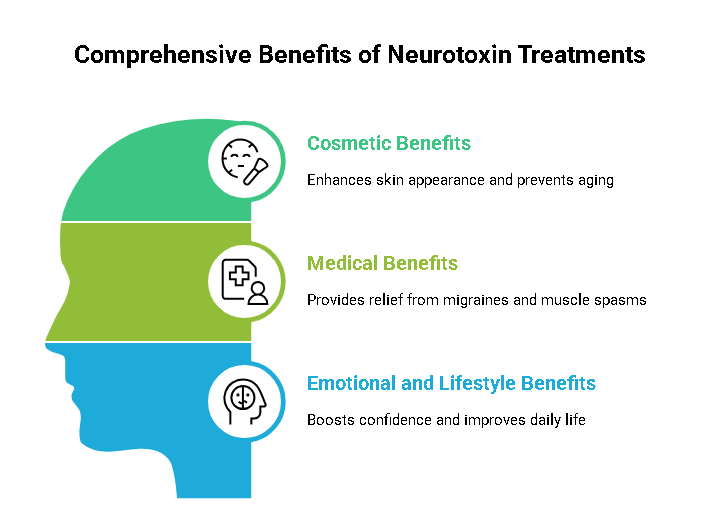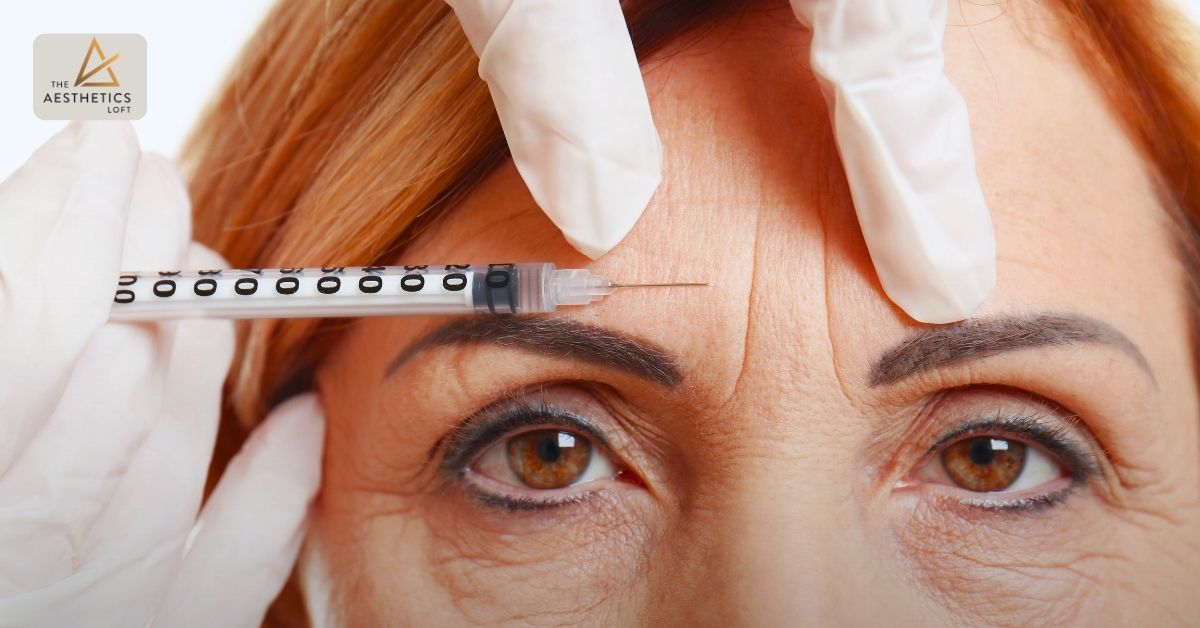Neurotoxins have quietly reshaped the aesthetics field, offering a way to smooth wrinkles and relax facial lines without surgery. You’ve probably heard of Botox — it’s the most famous name — but Botox is just one type of neurotoxin used in aesthetic treatments today.
At its core, a neurotoxin is a purified protein that temporarily blocks nerve signals to specific muscles. This reduces movement in areas that cause expression lines, such as the forehead or around the eyes, helping the skin appear smoother and more refreshed.
While often seen as a cosmetic tool, neurotoxins like Botox also have medical uses, including treating migraines, jaw tension, and excessive sweating. Their versatility and long-standing safety track record have made them a go-to choice for individuals seeking natural-looking enhancements with minimal downtime.
In this article, we’ll break down what neurotoxins are, how they work, their benefits, and the safety facts you need to know — so you can decide if they’re right for you. Let’s dive in.
What Are Neurotoxins in Aesthetics?
In aesthetics, neurotoxins are injectable substances used to relax overactive muscles that cause lines and wrinkles. They’re made from purified botulinum toxin type A, a substance that, in tiny doses, blocks the nerve signals that tell muscles to contract.
Every time we frown, squint, or raise our brows, small muscle contractions pull on the skin. Over time, these repeated movements create permanent lines — called dynamic wrinkles — especially on the forehead, around the eyes, and between the eyebrows. Neurotoxins target these muscles, helping the skin stay smoother when the muscles are at rest.
It’s a common myth that neurotoxins only “freeze” the face or make someone look emotionless. In reality, when done correctly, they soften specific muscles while leaving natural facial movement intact. It’s about balance, not erasing expressions.
There are several brands on the market. Botox is the best known, but Dysport, Xeomin, and Jeuveau work in similar ways. Each has slight differences in how they spread, how quickly they take effect, or how long they last — which is why providers may recommend one over another depending on the area treated and the patient’s needs.
Beyond cosmetics, neurotoxins are FDA-approved for various medical uses, including chronic migraines, muscle spasms, and excessive sweating. This wide range of applications speaks to their safety when used under expert care.
Understanding what neurotoxins are and how they differ from fillers or other treatments helps people make informed choices.
Types of Neurotoxins Used in Aesthetics
Neurotoxins used in aesthetics all contain botulinum toxin type A, but each product is made slightly differently. These small differences affect how they behave in the body — from how quickly they work, to how long they last, to how they spread under the skin.
Here’s a closer look at the four main types.
1. Botox
- The original brand is approved for both cosmetic and medical use.
- Known for precise, targeted action, making it ideal for small, specific areas like frown lines or crow’s feet.
- Starts working in 3–5 days, with full results at 1–2 weeks.
- Lasts around 3–4 months.
- Has the longest track record and the most clinical studies behind it, which is why many providers and patients trust it.
2. Dysport
- Similar to Botox, but has a slightly different protein structure.
- Diffuses (spreads) a bit more under the skin, making it well-suited for larger areas like the forehead or for patients wanting softer, more blended results.
- Often kicks in faster — sometimes within 1–3 days — though total duration is similar to Botox.
- Some patients say it feels “lighter” or more natural, though results are highly individual.
3. Xeomin
- Known as the “pure” neurotoxin, it contains no accessory proteins, just botulinum toxin.
- This may reduce the chance of the body developing antibodies that make treatment less effective over time.
- Often chosen for patients who’ve been using neurotoxins long-term or who want fewer additives.
- Works similarly in timing and duration to Botox.
4. Jeuveau
- The newest of the group, sometimes called “Newtox.”
- Designed specifically for cosmetic use (unlike Botox, which also has medical uses).
- Marketed as a Botox alternative with a focus on affordability and similar results.
- Early studies show comparable onset and longevity, but long-term research is still catching up.
How Do You Choose Between Them?
While they all work by relaxing muscles, the best option depends on the treatment area, desired effect, and your provider’s experience. Sometimes, patients may even switch between products over time to see which suits them best.
Now that you know the main types, let’s explore where these neurotoxins are used and why people choose them.
Where Are Neurotoxins Used? (Common Treatment Areas)
Neurotoxins are highly targeted — they’re not “one size fits all.” Trained injectors use them in precise spots where muscle movement causes lines or creates bulk. Here’s a breakdown of the most common treatment areas and why they’re chosen.
1. Forehead Lines
Horizontal lines from repeatedly raising the eyebrows. Neurotoxins relax the frontalis muscle, softening the creases without dropping the brows.
2. Frown Lines (Glabellar Lines or “11s”)
Vertical lines between the eyebrows are caused by frowning or concentrating. Treating the glabellar complex (corrugator and procerus muscles) smooths this area and can also give a slight brow lift.
3. Crow’s Feet
Fine lines at the outer corners of the eyes, mostly visible when smiling or squinting. Small injections around the orbicularis oculi muscle help smooth this area while keeping the eyes expressive.
4. Bunny Lines
Little wrinkles appear on the sides of the nose when scrunching or laughing. Neurotoxins relax the nasalis muscle to soften these lines.
5. Masseter Muscle (Jawline Slimming, TMJ, or Teeth Grinding Relief)
For people with a wide jaw or teeth grinding (bruxism), neurotoxin injections into the masseter muscle slim the lower face and reduce tension. This is both a cosmetic and a medical treatment.
6. Neck Bands (Platysmal Bands)
Vertical cords appear when clenching the neck. Injecting neurotoxin into the platysma muscle can smooth the neck and improve jawline definition.
7. Excessive Sweating (Hyperhidrosis)
Beyond the face, neurotoxins treat underarm, hand, or foot sweating by blocking nerve signals to sweat glands. This is a medical use with big quality-of-life benefits.
With so many uses, neurotoxins are more than just a beauty treatment — they’re a tool for comfort, confidence, and even pain relief. Next, let’s look at the key benefits they offer, both cosmetic and medical.
Benefits of Neurotoxin Treatments

Neurotoxin treatments offer more than just smoother skin. They provide both cosmetic and medical benefits, helping people look better, feel better, and, in many cases, live more comfortably. Here’s what makes them so popular.
1. Cosmetic Benefit
- Smoother, younger-looking skin: By softening muscle movement, neurotoxins help reduce visible lines, especially around the eyes, forehead, and brows.
- Preventative aging: Regular treatments can help prevent deeper wrinkles from forming, making them popular with people in their late 20s and 30s as a “prejuvenation” option.
- Natural-looking results: When done well, neurotoxins keep expressions natural, not frozen. They soften harsh lines while leaving your personality intact.
- Quick and convenient: Treatments typically take 10–30 minutes, with minimal downtime, making them easy to fit into a busy schedule.
2. Medical Benefits
- Migraine relief: Botox is FDA-approved to reduce the frequency of chronic migraines, offering a non-pill option for long-term headache sufferers.
- Jaw tension and TMJ relief: By relaxing the masseter muscle, neurotoxins can ease jaw pain, clenching, and teeth grinding, improving comfort and sometimes reshaping the lower face.
- Excessive sweating (hyperhidrosis): Neurotoxin injections under the arms, hands, or feet help control severe sweating that doesn’t respond to topical treatments.
- Muscle spasm treatment: Botox is used for conditions like cervical dystonia (neck spasms) and eye twitching, improving daily function and comfort.
3. Emotional and Lifestyle Benefits
- Boosted confidence: Many people feel more confident when they look rested and refreshed.
- Improved quality of life: Medical uses can reduce pain, tension, and discomfort, making everyday activities easier.
Are Neurotoxins Safe? Understanding the Risks and Safety Profile
Neurotoxins like Botox, Dysport, Xeomin, and Jeuveau have been widely used for decades, both for aesthetics and medical conditions. While each brand has slight differences, they all share a similar safety profile when used properly.
1. Proven Safety and FDA Approval
All four major neurotoxins are FDA-approved for cosmetic use and, in some cases, medical treatments. These products have been studied in clinical trials and used in millions of procedures worldwide, making them among the most researched injectables available.
2. Common, Temporary Side Effects
Most people experience little to no downtime. When side effects do happen, they are usually mild and short-lived:
- Redness, swelling, or small bruises at the injection points
- Mild headache or feeling slightly unwell
- Tenderness in the treated area
These effects typically fade within a few days.
3. Rare Risks to Be Aware Of
Serious complications are rare but possible. They include:
- Drooping eyelid or brow (if product migrates)
- Uneven results or muscle asymmetry
- Dry eyes or slight swallowing issues (with neck treatments)
These are temporary but can last a few weeks, emphasizing why provider experience matters.
4. Who Should Avoid Neurotoxins?
- Pregnant or breastfeeding individuals
- People with neuromuscular conditions like myasthenia gravis or ALS
- Anyone allergic to botulinum toxin or its components
Sharing your full medical history with your provider is the best way to ensure safety.
5. Why the Injector’s Skill Matters Across All Neurotoxins
No matter the brand, results depend on technique. A trained, licensed injector understands facial anatomy, knows the right doses, and tailors treatment to your unique features. Avoid discount providers or unlicensed settings — the risk isn’t worth the savings.
What to Expect Before, During, and After Neurotoxin Treatment
Knowing what happens at each stage helps you feel prepared and confident. Here’s a simple breakdown of what to expect when getting a neurotoxin treatment, whether it’s Botox, Dysport, Xeomin, or Jeuveau.
1. Before Treatment
- Consultation:
You’ll meet with a licensed injector to discuss your concerns, medical history, and goals. They’ll assess your facial anatomy, explain what’s realistic, and help choose the right neurotoxin and dosage. - Preparation:
Usually, no major prep is needed. However, you may be advised to avoid blood-thinning medications, alcohol, or supplements like fish oil for a few days to reduce bruising.
2. During the Procedure
- Quick and precise:
The treatment usually takes 10–30 minutes, depending on how many areas are being treated. - Small injections:
Using a fine needle, your provider places tiny amounts of neurotoxin into specific muscles. Most people describe the feeling as quick pinches or stings — very tolerable. - No numbing (usually):
Numbing cream is rarely needed, but can be used if you’re sensitive.
3. Aftercare and Recovery
- Minimal downtime:
You can typically return to work or activities right after. - Simple aftercare tips:
- Stay upright for a few hours.
- Skip heavy exercise the rest of the day.
- Avoid rubbing or massaging treated areas.
- When to see results:
Improvements usually start within 3–7 days, with full results at about two weeks. - How long does it last?
Most neurotoxins hold their effect for 3–4 months. Regular maintenance treatments are common, but you can adjust or stop anytime.
Choosing the Right Provider: Why Experience Matters
No matter which neurotoxin you’re getting — Botox, Dysport, Xeomin, or Jeuveau — the skill of the injector is what makes the difference between smooth, natural results and disappointing (or even unsafe) outcomes.
1. Why Expertise Counts
Neurotoxins work at the muscle level, and every face is unique. A trained, licensed injector understands:
- Facial anatomy and how muscles interact
- How much product to use for each area
- How to customize treatment for your face shape, expressions, and goals
This expertise reduces risks like drooping, uneven results, or a frozen look.
2. Who Should You See?
Look for:
- Board-certified dermatologists, plastic surgeons, or experienced nurse injectors (NPs, PAs)
- Clinics with medical supervision
- Providers who explain the procedure, answer questions, and help set realistic expectations.
Avoid non-medical spas, cheap deals, or unlicensed providers — these increase the risk of complications and poor results.
3. Questions to Ask During Consultation
- What neurotoxin brands do you offer, and why?
- How long have you been performing injections?
- What’s your approach to keeping results natural?
- What should I do if I’m unhappy with the results?
Asking these questions upfront helps you feel informed and empowered.
Conclusion: Making an Informed Choice About Neurotoxins
Neurotoxin treatments have earned their place as one of the most versatile tools in both cosmetic and medical care — not just because they smooth lines, but because they help people feel more comfortable and confident in their own skin.
But here’s the real takeaway: these treatments aren’t magic, and they’re not one-size-fits-all. What makes them successful isn’t just the product — it’s the thoughtful planning behind them, the skill of the injector, and how well they align with your goals and needs.
If you’re considering neurotoxin treatments, focus on:
- Understanding your own reasons — whether it’s softening wrinkles, preventing new ones, or improving a medical condition like migraines or jaw tension.
- Finding a qualified, experienced provider who listens, explains, and works with you — not just sells you something.
- Knowing that great results are about balance and subtlety, not chasing perfection.
When used thoughtfully, neurotoxins can be a tool to help you look and feel your best — without changing who you are. Make sure your decisions are guided by good information, expert care, and what matters most to you.

